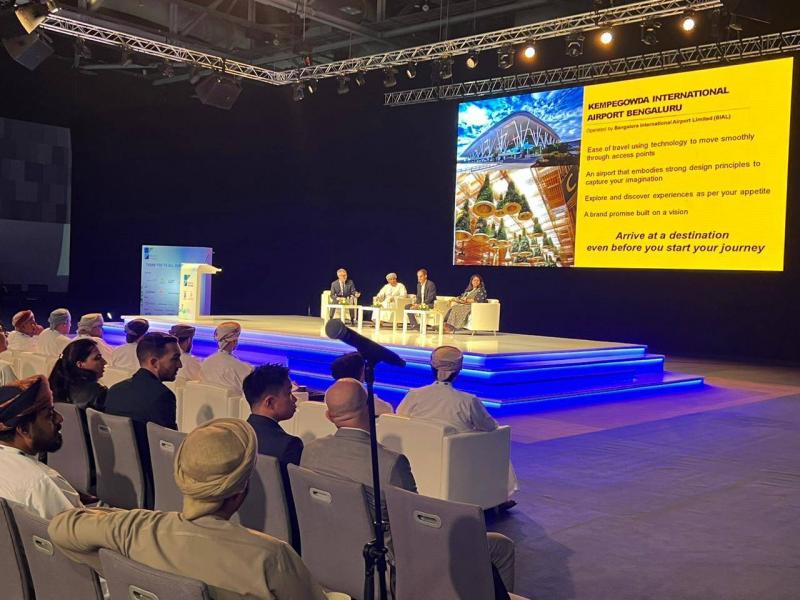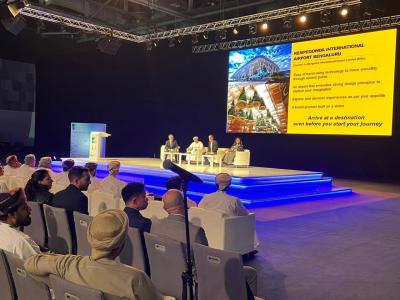Participants in the Airport Innovation Conference and Exhibition recently concluded their working sessions at the Oman Convention and Exhibition Centre, hosted by the Sultanate of Oman, represented by Oman Airports, in collaboration with the Airports Council International, from November 20 to 22, 2023. Over two days, participants discussed various papers during lively discussions about the future of innovation in the airport sector, focusing on the latest trends, developments, and technological innovations. CEOs and experts representing airports worldwide presented visual demonstrations exploring the sector’s readiness for innovation, delving into artificial intelligence and the latest technologies designed to enhance the travel experience and operational practices within airports.
Fourteen global institutions showcased their latest airport products at the exhibition held alongside the conference, featuring several local tech startups highlighting their innovations in aviation and airport management. The second day’s sessions addressed brand strategy and innovation as new steps toward creating a customer-focused brand, recognizing that airports are no longer mere transit centers but captivating destinations for both travelers and non-travelers alike. Airport operators are now investing significant resources in comprehensive marketing strategies and branding to establish themselves as reputable brands.
Airports have replaced traditional marketing approaches with innovative strategies. Participants shared their airports' digital transformation efforts to create dynamic and engaging environments for travelers. Loyalty programs, previously overlooked in airport contexts, have now become integral parts of strategies aiming to build positive perceptions among passengers. Furthermore, the discussions touched on creating dynamically comfortable environments by showcasing art and culture to foster a sense of place.
Airports are leveraging influencer marketing to engage with travelers through innovative marketing and branding initiatives, striving to create lasting impressions and ultimately drive revenue streams. Another workshop discussed the complete digitization process and operational excellence, enhancing passenger experiences within airports, increasing revenue generation focus, cost optimization, and reducing carbon footprints. Communication plays an increasingly vital role, becoming a core strategic asset for the airport, akin to the importance of runways.
One session examined airports' roles in establishing laboratories and innovation centers within the airport vicinity, aiming for dual benefits by implementing cutting-edge technologies while supporting small startups and individual developers to use airports as real-world testbeds from concept to marketing. Presenters highlighted the most successful projects sponsored by these centers. Through innovation, airports can ensure their leadership in this technological revolution, deepening the potential benefits of the aviation industry in the future.
Work sessions addressed how data in the airport sector can improve operational performance, enhance customer experience development, and increase new revenue streams. A panel discussion focused on risk management to achieve sustainability and resilience in airport operations, covering aspects like renewable energy, water conservation, and waste reduction—strategies that effectively mitigate risks and enhance airport resilience. Another session provided valuable insights into mobility regarding key risks airports face, such as natural disasters, terrorism, and cyber threats, discussing the role of risk management and insurance in mitigating these challenges to create sustainable and resilient airport environments.
Amid the ongoing green transitional phase of airport infrastructure aimed at decarbonizing the aviation industry, the conference presented a toolkit to help airports identify the most efficient and effective ways to fund this transformation. The role of generative artificial intelligence was also addressed as a new opportunity for airport management to enhance non-aeronautical revenue streams. The conference underlined the importance of leveraging advanced natural language capabilities, asserting that generative AI can assist in creating targeted retail, dining, and entertainment concepts that align with passenger demographics and preferences.
Additionally, generative AI can aid in redesigning dynamic digital advertising platforms, allowing airports to tailor promotional offerings and partnerships in real-time based on passenger flow, seasonal travel trends, and other data sources. With the creative potential of AI, airport managers can develop innovative revenue-generating amenities, services, and promotions that complement core aviation operations. While ensuring efficient and secure core operations remains a priority, generative AI provides emerging tools for airport management to creatively boost non-ticket related revenue sources.
The conference also addressed the carbon footprint of baggage journeys, noting it is time to focus on reducing the environmental impact of baggage travel to achieve full decarbonization in the aviation industry. Work sessions discussed technology as a fundamental means to achieve a barrier-free transport system through innovative solutions that facilitate the travel journey of disabled and limited-mobility passengers, enabling airports to create seamless travel experiences through new access routes.
One of the workpapers emphasized that despite technological advancements and the implementation of automated equipment easing pressure on the current airport workforce by enhancing efficiency and productivity, no machines can replace this workforce. The session called on HR experts worldwide to share initiatives ensuring the aviation workforce is prepared for the future, especially after witnessing many skilled aviation professionals leave the sector for better opportunities in different fields post-pandemic.
During the conference, airport leaders discussed how to embed a culture of innovation within the airport ecosystem and the challenges they face, encouraging the adoption and nurturing of innovative ideas throughout the airport to thrive in operational quality and service.
Given the constantly evolving industry trends and new technologies, attendees conversed about creating a smart, green airport designed for scalability and simplicity in architecture, relying on the highest expertise through the next generation of all optical networking solutions and optical sensor surroundings based on service scenarios. A participant presented a paper on future airports, focusing on designs for tomorrow's airports, sustainable architecture, autonomous shuttles, and smart infrastructure for seamless connectivity.
The sessions explored the role of airport operators in maximizing the advantages of artificial intelligence and big data in the future to streamline operations and deliver next-level travel experiences. Notably, AI is increasingly being applied across various airport operations to improve efficiency and enhance the overall passenger experience—covering chatbots, real-time baggage tracking, facial recognition for check-in and boarding, predictive analytics for process optimization, and more. Many expect that artificial intelligence and big data will undoubtedly drive airports to transition into the future.




